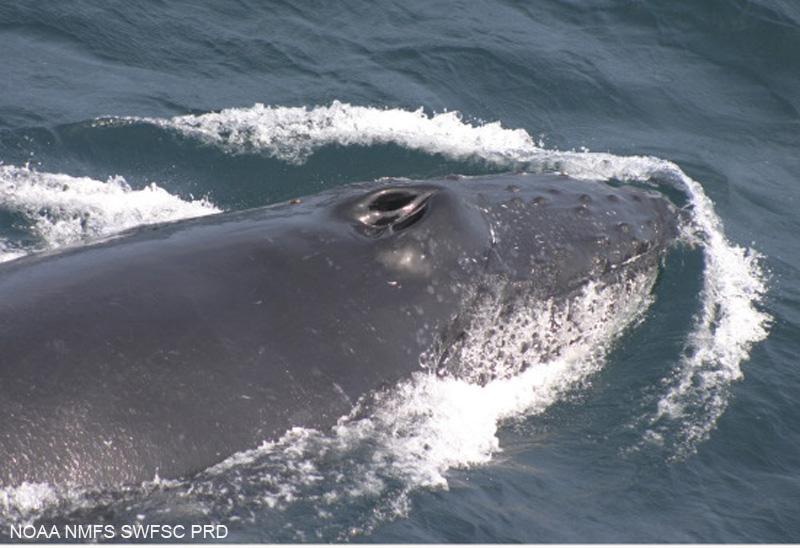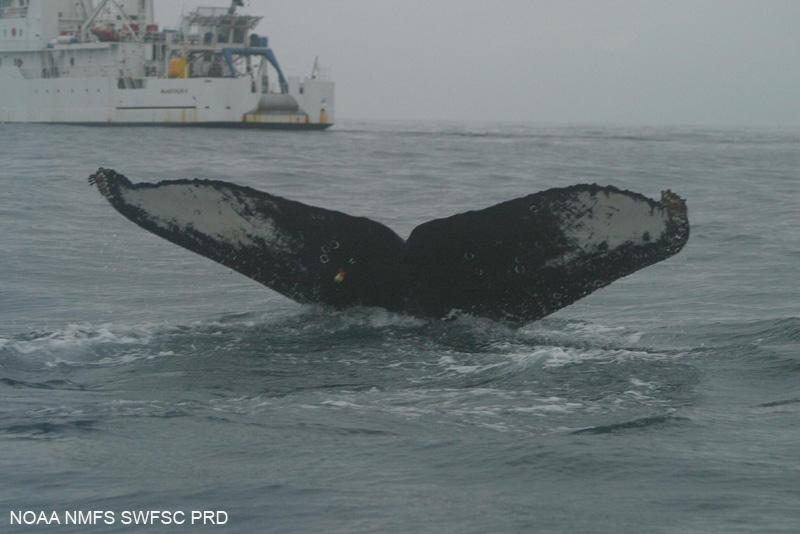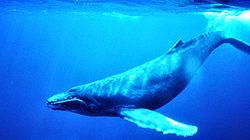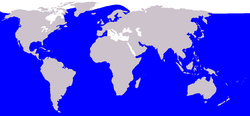Common Name: Humpback Whale
The Arabian Sea humpback whale population is ‘Endangered’ and remains in the northern Arabian Sea from Yemen in the west to Gujarat in the east.
General Description: The body of a Humpback Whale is more robust than those of the other rorquals. The top of the head is flattened and covered by a number of fleshy knobs. There is a round protuberance at the tip of the lower jaw.
From above, the head is broad and rounded. Unlike the other rorquals, the ridge along the midline on top of the head is indistinct. The number of throat grooves is 14 to 35, extending to the navel. The dorsal fin is located less than one-third of the body length from the tail fluke notch. It may be small and triangular, or larger and sickle-shaped. It frequently includes a step or hump, giving the species its common name. A Humpback’s flippers are very long, measuring about one-third of the total length. They are scalloped with knobs or bumps.
Humpbacks are black or grey, with a white region on the throat and belly. The flippers are white underneath, sometimes above as well. The tail flukes are broad and butterfly-shaped, and have some white below.

Size: Adults, Humpback males grow to a length of 15 m, and females to 16 m. Weights as given by different sources vary from 25 to about 65 tons. Calves at birth, 4.5m long.
Appearance At Sea: Usually seen in family groups of three or four, Humpbacks produce a single bushy spout up to 3 m high.
Some Humpbacks leap out of the water and lobtail prior to feeding. Humpbacks appear to enjoy breaching, and this type of behaviour attracts tourists to watch them off the east coast of the USA. A breaching Humpback launches gracefully into the air and executes a half-twist so that it lands on its back. One young animal in the Caribbean was noted breaching 130 times over 75 minutes.
Seagulls steal fish from Humpbacks’ open mouths, but careless birds may be swallowed accidentally. The stomach of a Humpback Whale that washed ashore in England in 1825 was found to contain six sea birds.
Commercial whaling has taken its toll of Humpback Whale populations. Complete protection since 1964 has failed to bring up today’s stocks higher than 10 percent of their pre-exploitation level.
The singing of Humpbacks at their breeding grounds is now famous. Their songs are audible from far away. These whales do not sing at their feeding grounds, though they do communicate with each other.

Found In: Whales are found in coastal and shelf-edge waters. They feed on swarming crustaceans and shoaling fish.
Records from India: One Humpback Whale was stranded near Quilon in 1943. The next record from India is of a dead one that was washed ashore near Kasaragod in January 1988. This was probably the same carcass that turned up at Nileswaram five days later. In January 2001 a Humpback Whale was landed in southern Tamil Nadu. A humpback whale was entangled off the coast of Mangrol in 2006 and released by fishers. A live humpback whale stranded at Una, Gujarat in September 2017 and a singing whale was recorded off the coast of Goa in 2017 too. Humpback whales have also been sighted off the coast of Jakhau by the Indian Coast Gaurd.
World Distribution: These whales are widely distributed in all oceans.
Could Be Confused With:At a distance, Humpback Whales may look a little like some rorquals, but the Humpback is set apart from them by its habit of raising the tail flukes before sounding. Great Sperm Whales Physeter macrocephalus also throw their tails in the air but they do not have any white markings on them.
Diagnostic Features:At sea, Small dorsal fin mounted on a fleshy step or platform, enormous flippers, broad tail flukes with white markings.
Stranded Specimens:The fleshy knobs on head and the protuberance at the tip of the lower jaw are distinctive. The baleen is also characteristic.There are 270 to 400 baleen plates on each side, the largest being up to 70 cm long and 30 cm wide. They are black with black or olive-black bristles.




